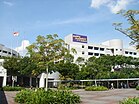
Back North-East Region (Singapur) German Région du nord-est (Singapour) French Wilayah Timur-Laut (Singapura) ID North-East Region Dutch Северо-Восточный регион (Сингапур) Russian North East Region (Singapore) Swedish شمالی-مشرقی علاقہ، سنگاپور Urdu Vùng Đông-Bắc, Singapore Vietnamese 東北區 (新加坡) Chinese Tang-pak-khu (Sin-ka-pho) ZH-MIN-NAN
North-East Region | |
|---|---|
From top left to right: Terraced houses in Serangoon, HDB flats in Hougang, Sengkang LRT Line, Waterway Point, Nanyang Polytechnic | |
 Subzones 27 to 33 in orange makes up the North-East Region of Singapore. | |
| Coordinates: 1°23′30″N 103°53′40″E / 1.39167°N 103.89444°E | |
| Country | |
| Planning Areas |
|
| CDC | |
| Regional centre | Seletar |
| Largest PA | Sengkang |
| Government | |
| • Mayors | Central Singapore CDC
North East CDC North West CDC South East CDC |
| Area | |
| • Total | 103.9 km2 (40.1 sq mi) |
| Population (2020)[2] | |
| • Total | 930,910 |
| • Density | 9,000/km2 (23,000/sq mi) |
The North-East Region (Chinese: 東北區) of Singapore is one of the five regions in the country. The region is the most densely populated and has the highest population among the five, with Sengkang being its most populous town as of 2020 and Seletar as the regional centre. Comprising 13,810 hectares, it includes seven planning areas and is largely a residential region with 217,120 homes.[3] Housing largely consists of high-density HDB public housing estates, however private housing is also present in the region. As its name implies, it is located in the north-eastern part of Singapore.[4]
The North-East Region, along with the four other planning regions, was officially established by the Urban Redevelopment Authority in 1999.[5] Prior to the 1970s, the region was predominantly rural and experienced very little urbanisation. It was only with the development of towns such as Ang Mo Kio and Hougang over the next few decades that the region began to grow significantly in population and experienced dramatic urban development. As of 2020, the North-East Region has a population of 930,910.[6] While predominantly a residential region, the North-East Region is also home to tourist attractions, such as Pulau Ubin and Coney Island. The region has a number of hospitals, parks, educational facilities, and security and defence services. There are also a variety of transport options, including Mass Rapid Transit, Light Rail Transit and public bus services, facilitating transport within and outside the region.
- ^ City Population - statistics, maps and charts | SINGAPORE: Regions
- ^ "Population Trends". Base. Retrieved 2021-05-16.
- ^ "Key Statistics FY 2014/2015". Singapore Statistics. 2015. Archived from the original on 2016-03-04.
- ^ http://www.ura.gov.sg/DMP2008/northeast.htm
- ^ "Development guide plans | Infopedia". eresources.nlb.gov.sg. Retrieved 2021-05-30.
- ^ Cite error: The named reference
:3was invoked but never defined (see the help page).




